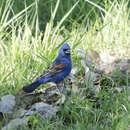en
names in breadcrumbs


A large (6-7 ½ inches) bunting, the male Blue Grosbeak is most easily identified by its dark blue body, chestnut and tan wing stripes, and large conical bill. The female Blue Grosbeak is brown overall with dark wings and orange wing bars. This species is most easily distinguished from the related Indigo Bunting (Passerina cyanea) by the latter species’ smaller size and paler plumage in both sexes. The Blue Grosbeak breeds across the southern half of the United States and northern Mexico. In winter, these populations migrate south to southern Mexico and the east coast of Central America. Blue Grosbeaks are present all year in the highlands of central Mexico and the west coast of Central America. Blue Grosbeaks breed in and around shrubby edges of deciduous and evergreen woodland. During the winter, this species may be found in overgrown fields and clearings in humid tropical forests. Blue Grosbeaks primarily eat insects and seeds. In appropriate habitat, Blue Grosbeaks may be seen foraging for food in shrubs and low tree branches. Birdwatchers may also listen for this species’ song, a series of warbled notes recalling that of a finch. Blue Grosbeaks are primarily active during the day.
A large (6-7 ½ inches) bunting, the male Blue Grosbeak is most easily identified by its dark blue body, chestnut and tan wing stripes, and large conical bill. The female Blue Grosbeak is brown overall with dark wings and orange wing bars. This species is most easily distinguished from the related Indigo Bunting (Passerina cyanea) by the latter species’ smaller size and paler plumage in both sexes. The Blue Grosbeak breeds across the southern half of the United States and northern Mexico. In winter, these populations migrate south to southern Mexico and the east coast of Central America. Blue Grosbeaks are present all year in the highlands of central Mexico and the west coast of Central America. Blue Grosbeaks breed in and around shrubby edges of deciduous and evergreen woodland. During the winter, this species may be found in overgrown fields and clearings in humid tropical forests. Blue Grosbeaks primarily eat insects and seeds. In appropriate habitat, Blue Grosbeaks may be seen foraging for food in shrubs and low tree branches. Birdwatchers may also listen for this species’ song, a series of warbled notes recalling that of a finch. Blue Grosbeaks are primarily active during the day.
The blue grosbeak (Passerina caerulea), is a medium-sized North American passerine bird in the cardinal family Cardinalidae. It is mainly migratory, wintering in Central America and breeding in northern Mexico and the southern United States. The male is blue with two brown wing bars. The female is mainly brown with scattered blue feathers on the upperparts and two brown wing bars.
The blue grosbeak was formally described by the Swedish naturalist Carl Linnaeus in 1758 in the tenth edition of his Systema Naturae under the binomial name Loxia caerulea.[2] The specific epithet caerulea is the Latin word for "blue", "azure-blue", "sky-blue" or "dark-blue".[3] Linnaeus based his own description on the "blew gross-beak" described and illustrated by Mark Catesby in his The Natural History of Carolina, Florida and the Bahama Islands. The book had been published in 1729–1732.[4] Catesby gave the location as Carolina and Linnaeus specified America. The type location is now restricted to South Carolina.[5]
Some taxonomists placed the blue grosbeak in its own monotypic genus Guiraca but in 2001 a molecular phylogenetic study of mitochondrial DNA sequences found that the blue grosbeak, in spite of being physically larger, nested within the Passerina and was most closely related to the lazuli bunting.[6] The species is therefore now placed with the North American buntings in Passerina, a genus that was introduced by the French ornithologist Louis Jean Pierre Vieillot in 1816.[7][8]
Seven subspecies are recognised:[8]
The male blue grosbeak is deep blue, with both black and brown on its wings. The female is mostly brown. Both sexes are distinguished by their large, deep bill and double wing bars. These features, as well as the grosbeak's relatively larger size, distinguish this species from the indigo bunting. Length can range from 14 to 19 cm (5.5 to 7.5 in) and wingspan is from 26 to 29 cm (10 to 11 in).[9][10] Body mass is typically from 26 to 31.5 g (0.92 to 1.11 oz).[11]
This is a migratory bird, with nesting grounds across most of the southern half of the United States and much of northern Mexico, migrating south to Central America and in very small numbers to northern South America; the southernmost record comes from eastern Ecuador.
This species is found in partly open habitat with scattered trees, riparian woodland, scrub, thickets, cultivated lands, woodland edges, overgrown fields, or hedgerows.
The blue grosbeak nests in a low tree or bush or a tangle of vegetation, usually about 1–2.5 m (3.3–8.2 ft) above ground, often at the edge of an open area.[12]
It eats mostly insects, but it will also eat snails, spiders, seeds, grains, and wild fruits. The blue grosbeak forages mainly on the ground.[13]
The blue grosbeak (Passerina caerulea), is a medium-sized North American passerine bird in the cardinal family Cardinalidae. It is mainly migratory, wintering in Central America and breeding in northern Mexico and the southern United States. The male is blue with two brown wing bars. The female is mainly brown with scattered blue feathers on the upperparts and two brown wing bars.